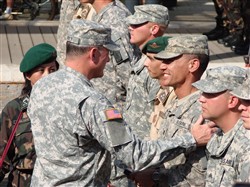Operation Rhino Serpent 2012: US, German, British medical troops learn from one another during exercise
From left, U.S. Army Pfc. Vernisha Browne, 212th Combat Support Hospital out of Miesau, Germany, a German soldier, British army Sgt. Andrew Hunter and U.S. Army Pfc. Rachel Nuñez, 212th CSH, stabilize a simulated casualty Sept. 14 during Operation Rhino Serpent at Sennelager Training Area, Germany. Rhino Serpent was a joint medical training exercise for U.S., British and German armed forces.
Related Topics (6)
More related topics
SENNELAGER TRAINING AREA, Germany - "Ambulance inbound," a voice boomed, and troops from the United Kingdom's 2nd Medical Regiment immediately prepared to receive a German ambulance transporting a "victim" injured by an improvised explosive device here, Sept. 15.
As the patient - actor and real-life amputee Raymond Bays - alternated between yelling in pain and slipping into unconsciousness, the medics and doctors from the German army's Medical Regiment 22 and the 2nd Medical Regiment (based in Bergen-Hohne, Germany) worked in tandem to stabilize Bays until he was able to be transported to the Combat Support Hospital. There, he was treated by medical personnel from 30th Medical Command's 212th CSH out of Miesau, Germany, the 202 (Midlands) Field Hospital and the 335th Medical Evacuation Regiment, both based in England.
The scenario was part of Operation Rhino Serpent, a multi-national medical field training exercise comprised of more than 550 U.S. Army Europe, German Armed Forces and British Armed Forces active duty Reservists and volunteers. The exercise culminated in a 96-hour simulated event, where "deployed" British and German medics cleared the battlefield of casualties to a U.S. Combat Support Hospital staffed by U.S., British and German personnel.
"It's very important to train together so that when something happens - such as now, when an ambulance appears - everything runs smoothly. And in the next deployment, wherever that may be, we've got things worked out so there are no problems going in," said British army 2nd Lt. Graeme Hogg, 2nd Medical Regiment troop commander.
The exercise combined multinational healthcare with preparation for contingency and programmed operations in the fictional landlocked, poor and divided country of Curi, but can be anywhere in the world, said 1st Lt. Brian Thorson, the S4 for 212th CSH.
"The current operations that most U.S. units find themselves in is presently in Afghanistan. We're transitioning from an army at war to an army that is preparing for contingency operations. Essentially what that means for us is we need to be ready to prepare at any time, at any place, anywhere," Thorson said.
Careful consideration was made by planners to make the scenarios as realistic as possible, down to troops living and working out of tents, eating meals, ready-to-eat and having no communication with the outside world, Thorson added.
"These are all things that add to realism to training for future scenarios," Thorson said.
The realism of the environment - combined with the injuries sustained by victims, who ranged from Bays' IED blast to a British army private who presented with a large nail through her hand - made medical personnel unsure of when the next rush would be, or what it would entail.
"[At this point] I've treated IEDs, heart attacks, nausea, vomiting, broken legs and children, as well as military working dogs, which are treated as if they were Soldiers," said Capt. Nathan Beckerman, 212th CSH emergency physician.
Each patient was cared for as though the situation were real, but the available IVs, tourniquets and X-rays were not used due to safety reasons, Beckerman added.
With the exception of the animals and children, in which mannequins were used, all cases involved actors hired by Trauma FX, a company from North Yorkshire, England, that specializes in casualty situation makeup, amputee effects and more.
Managing Director Linzi Foxcroft said she often recruits injured combat veterans as actors, including Bays and Ruben Carvil, a Glendora, Calif., native and veteran of the U.S. Air Force, who has resided in England since 2007. With fellow artist Joanna Parvin, the two use realistic props, makeup and large amounts of fake blood to make the wounds appear as they really would right after occurring.
"It's a lot of fun. And what's really satisfying, is when people who've done tours come over and say, 'You know what? I worked with you last year, and it really helped me through the tour, and I had to actually treat somebody.' That's probably the most satisfying part of the whole job," Carvil said.
The actors stayed in character from the moment they were transported from the Trauma FX building in the ambulance to the time they were released, or when the mission was ended, whichever came first. In some cases, that meant the patients spent a few days in the mobile CSH, "recovering."
The CSH was a maze of tents hooked together to make rooms and hallways. Like most permanent hospitals, it included an intensive care unit, ICU wards, operating space, a pharmacy, lab, laundry and more, said Capt. Patrick Kadilak, officer-in-charge of the Emergency Medical Technician section, 212th CSH. It can be configurated into a 44-bed, 84-bed or 284-bed hospital, but was made into an 84-bed hospital for the exercise.
According to Thorson, the hospital can be completely set up in a matter of days, which is in line with the 212th's goal of deploying all personnel within 96 hours of being alerted.
"Whatever mission we receive in the future, with who[m]ever we're paired together, we know how to work through those issues now," Thorson said. "This is what we're training for, to become more and more independent."
Find more articles tagged with:
-

Despite the cold: U.S. military partnerships key to Arctic crisis response
The scenario used during SAREX 2012— a multinational exercise held recently in Greenland’s eastern sea – tested military and civilian capabilities for search and rescue missions above the Arctic Circle. Meanwhile, during exercise Northern Eagle, a U.S. Navy destroyer joined Russian and Norwegian vessels in the Barents Seas to prepare for similar rescues, plus anti-piracy operations and joint air defense.Find more articles tagged with:
-
Civic leaders receive preview of Baumholder's future
Leaders of the U.S. Army Garrison Baumholder, the 170th Infantry Brigade Combat Team and local civic leaders came together for a garrison hosted civic leaders working luncheon recently in the Rheinlander Community Club to discuss issues affecting the military and civilian communities.Find more articles tagged with:
-
This Week in EUCOM History: Sept. 30-Oct. 6, 1990
Less than one year after the destruction of the Berlin Wall, East and West Germany come together on what is known as "Unity Day."Find more articles tagged with:
-

USACE forward engineers train with Italians
A U.S. Army Corps of Engineers Forward Engineering Support Team-Advance (FEST-A) conducted training and remote engineering missions in partnership with Italian Army Reconnaissance Engineers here September 9-21, 2012.Find more articles tagged with:
-

Princess unveils WWII memorial at RAF Greenham Common
Her Royal Highness, Princess Anne, The Princess Royal officially dedicated three memorial stones for U.S. Visiting Forces at the Greenham Business Park in Greenham Common, United Kingdom, Sept. 21.Find more articles tagged with:
-

Schweinfurt flexes combat capability muscle with NATO exercise
Despite its announced closure earlier this year, the U.S. Army garrison here still has something to prove: Pitted between closing and remaining operational, it can also host a large-scale NATO exercise in its own backyard.Find more articles tagged with:
-

Ceremony ends 18th Combined Endeavor
On Sept. 20, a closing ceremony at the Joint Military Training Command on U.S. Army Garrison Grafenwoehr, Germany, ended the 18th year of the world’s largest military communications exercise, Combined Endeavor 2012.Find more articles tagged with:
-

173rd Airborne Brigade, Italian carabinieri share training, experiences
Noncommissioned officers from the rear detachment of U.S. Army Europe's 173rd Airborne Brigade Combat Team shared deployment experiences and lessons learned with Italian military law enforcement officers during cultural awareness and information operations training here, Sept. 11.Find more articles tagged with:
-

Kansas National Guard partners with HDTC for Humanitarian Demining in Armenia
Four soldiers from the Kansas National Guard are working with a civilian representative from the U.S. Humanitarian Demining Training Center to teach international Humanitarian Mine Action standards to members of the Engineering Companies of the Armenian Peacekeeping Brigades Sept. 18-28.Find more articles tagged with:
-
Panther PacStar makes debut at CE12
For the 20 Airmen of the 1st Combat Communications Squadron, Ramstein Air Base, Germany, supporting Combined Endeavor 2012, this could potentially be a real scenario for them.Find more articles tagged with:














Comments: 0